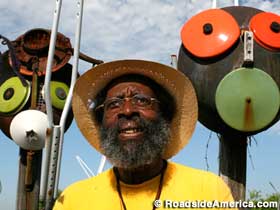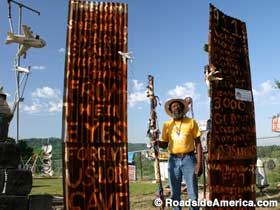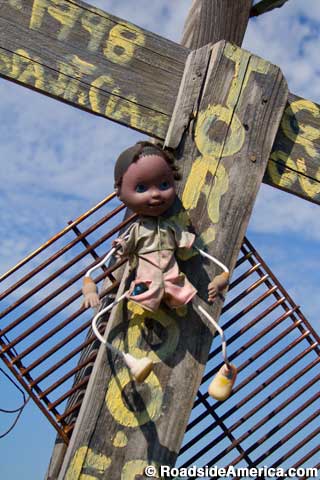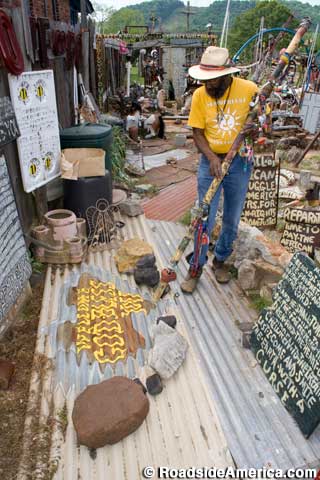
African Village in America
Birmingham, Alabama
"This ain't nothing but God's blueprint here," said Joe Minter, sweeping his hand across his yard on the southwest tip of Birmingham. "There ain't no way that a man could put all this down here together without instructions from God."
Joe's been following the Divine Road Map since 1989, when he started packing the lawn and yard around his house with shrines and totems. He called it African Village in America, and its theme is African-American history, with occasional diversions. Joe's used whatever he could get his hands on to build it: old sports equipment, baking pans, footwear, Christmas lawn decorations, hubcaps, lots of toys and dolls. "God said, 'Pick up what's thrown away and put it together,' Joe said. "Whatever God gives me, that's what I work with."

With a firm grasp on his jingly keychain decorated "talking stick," Joe led us into the dense alleys and pathways of African Village. Barbecue grill lids and floor fans are painted like African masks; wicker rakes double as feather headdresses; aluminum crutches on poles -- dozens of them -- as warrior spears. Huge placards made of plywood and pickup truck tailgates are filled with Joe's bold painted lettering of historical facts, Biblical passages, and pleas for heavenly mercy.
A tower of five satellite dishes spells "JESUS" and stands at a back corner of the yard, perhaps relaying messages from On High. Just beyond them are headstones, stretching to the horizon (Joe's land overlooks two immense African American cemeteries). "This is like woven into the ancestral burial ground, like it's a natural part of it," said Joe of his lawn. "There's over 100,000 Africans buried here. I'm standing on their shoulders." Including those of his father, who's buried just outside the property line.

Joe led us to his disaster memorials. Two rusty sheets of corrugated iron unmistakably represent the World Trade Center towers, with small plastic jetliners wired onto the impact positions. On one side are mailboxes on poles; one is labeled, "Pipe Bomb U.S.A.," another, "USA Anthrax," with its little raised flag painted "God Save Us." On the other side is an old iron boiler that's been turned into a nuclear missile: "USA The End."
Most of Joe's creations are meant to be morally or politically instructive. He patiently tried to explain them to us, but we were often distracted by his ingenious recycling of local cast-offs at every turn. "African Warrior" has rubber gloves for hands, wooden boards for arms, and eyes made of goggly metal kitchen sink drains. Lynching is represented by a shirt that's been filled out with stuffing, which is lying on the ground, wrapped in rusty chains, a noose around its collar.
His elaborate "Death Penalty" sculpture interweaves a homemade electric chair, lethal injection table, and two phones for the governor's reprieve.
A jumble of toy cars, plastic horsemen, baby heads, and empty shoes conveys the chaos and terror of the Pettus Bridge police attack of 1965. A "Slave Ship" is made of old railroad cross-ties, while scattered around it are rubber sharks and toy "Hulk Smash!" fists with shackled wrists. "The Native American had the Trail of Tears," Joe explained. "The African had the Trail of Chains and Sharks."

Joe Minter stands surrounded by his folk art.
Despite his sometimes grim material, Joe is quick to laugh and seems delighted to show people around his yard. His neighbors have had no problem with his African Village, and while Joe has had thoughts about his eventual retirement (he was born in 1943), he shows no sign of slowing down for now.
"Whenever I said I'm ready to give up, my wife would pat me on the back and say, 'No, somebody cares, just keep on working,'" Joe told us. "I got a calling. So I got to keep on."





